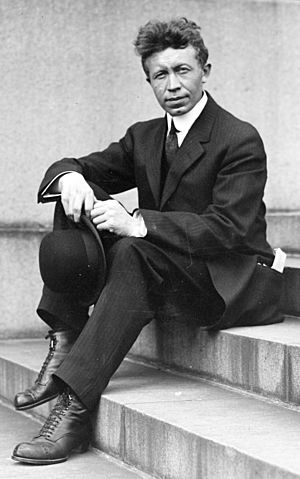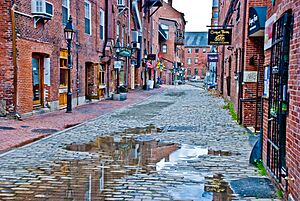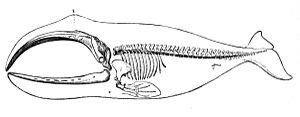George Baker Leavitt Sr. facts for kids
George Baker Leavitt Sr. (1860–1925) was a brave sea captain from Maine. He led many whaling ships from New Bedford, Massachusetts. These ships hunted whales in the cold waters near the Alaska North Slope. While there, Captain Leavitt met and married an Inupiaq woman. He also became friends with many early explorers of the Arctic. He helped them by giving them supplies and rides, and he even joined some of their explorations. An island called Leavitt Island in Harrison Bay (part of the Beaufort Sea) is named after him.
Contents
Early Life and Becoming a Sea Captain
George Baker Leavitt was born in Portland, Maine, on June 5, 1860. His father, George Washington Leavitt, died in the American Civil War soon after George was born. His mother, Helen E. (Greene) Leavitt, later remarried. George grew up in Portland with his mother and three half-siblings.
Like many young men from Maine, George Leavitt chose a life at sea. He started his career on whaling ships that sailed from New Bedford, a busy seaport in Massachusetts. Leavitt began working on these ships when he was young. He started in smaller roles, like second mate. Eventually, he became a captain himself. He commanded several whaling ships, including the Mary D. Hume, the Thrasher, the Grampus, the Balaena, and the steam-powered ships Newport and Narwhal.
Hunting Whales in the Arctic
Captain Leavitt arrived in the Canadian Arctic in the late 1800s. Whaling ships from New England and San Francisco were chasing whales into the icy northern seas. The bones in the heads of bowhead whales were very valuable. They contained oil and brought big profits to the whalers.
Whaling captains would leave San Francisco in early summer. They would hunt whales in the Beaufort Sea for about eight to ten weeks. When new ice started to form in September, they would spend the winter at Herschel Island, Canada. In early summer, as soon as the ice melted, the ships would leave Herschel Island. They would take their catch from the past year to San Francisco through the Bering Strait. In San Francisco, they would sell the whale products. Then they would get their ships ready and go back north to repeat the process.
Whaling was hard work, but captains and crews were paid well if they caught whales. For example, in 1907, Captain Leavitt and his ship, the Narwhal, caught about 15 bowhead whales. The captain received one-twelfth of the money from the catch. The first mate got one twenty-second, and other sailors received smaller amounts. Even new sailors, called "green hands," received a small share. Engineers on the ship earned a set salary each month.
The work was very tiring and complex. It included sailing, hunting whales with metal harpoon guns, and managing supplies. In the winter of 1896, several ship crews faced starvation. The frozen seas stopped new supplies from reaching them. First Lieutenant D. H. Jarvis wrote about this time. He said Captains Leavitt and McKenna did "heroic work" to keep their crews fed.
Injuries were common on whaling ships. Captain Leavitt wrote about many amputations that happened in the fleet. He and other captains often performed these operations themselves. On March 9, 1894, Captain Leavitt wrote about a man who had both feet amputated. He described how they used canvas to pull back the flesh before cutting the bones. He noted that the operation "turned out very well indeed."
Captain Leavitt's Adventures

Being a whaling captain was not for the faint-hearted. Besides injuries, the ice and freezing waters were very dangerous. One summer, the ice was so thick that ships could not pass Nelson Head until August 14. Captain Leavitt wrote in his log that the ice was "solid all the way across" to Cape Parry. Many early ships, like the schooner Bonanza, got stuck in the ice and were destroyed.
In another scary event, Leavitt and other captains watched eight whaling ships get trapped in the ice off Alaska's northern coast. John Taliaferro wrote about this 1898 incident in his book In A Far Country. He said that Captains James McKenna and George Leavitt reported seeing another whaler, the Navarch, drifting in the ice pack.
Whaling was a very complex job. To help him understand the weather and the land, Captain Leavitt hired a Native Inuit guide named Natkusiak (around 1885–1947). Natkusiak helped him on his trips across the Arctic seas. This included trips to islands like Norway Island, where other whalers had not dared to go.
Natkusiak worked for Leavitt for several years. During this time, the steam whaler Narwhal was spending the winter at Herschel Island (1906–1907) with Leavitt as captain. This is where the Arctic explorer Vilhjalmur Stefansson first met Leavitt and Natkusiak. Leavitt and Stefansson became good friends. Leavitt often gave Stefansson advice about the area. He also brought him supplies from the American Museum of Natural History in New York City. In 1908, Stefansson hired Natkusiak, who then helped the explorer on his later trips.
Leavitt himself gave Stefansson much advice and support. Stefansson often quoted Leavitt in his journals and called him an "explorer" as well as a "captain." Stefansson noted that Leavitt was very brave in his sailing. He often sailed to places others could not reach. Stefansson wrote, "Captain Leavitt had told me that the Narwhal was the only ship of the whaling fleet that ever went to Norway Island."
Stefansson often wrote about his friendship with Captain Leavitt in his journals. He mentioned how Captain Leavitt had hosted him on the Narwhal at Herschel Island. Leavitt also brought him important supplies like ammunition, kerosene, and alcohol for preserving scientific samples.
Stefansson was not the only explorer who benefited from Captain Leavitt's help. Ernest de Koven Leffingwell, another early Arctic explorer and mapmaker, often traveled on Captain Leavitt's ships. In 1908, Leffingwell's own ship, The Duchess of Bedford, got trapped and destroyed in the Arctic ice. Captain Leavitt then gave Leffingwell and his group a ride back to San Francisco. To show his thanks, Leffingwell named an island Narwhal, after Leavitt's ship. He also named another island, off Alaska's North Slope, Leavitt Island, after his friend the captain.
After his ship was destroyed, Leffingwell could not continue his work. He wrote that he "returned to civilization in the fall of 1908 as guest of Capt. George Leavitt, of the whale ship Narwhal."
Family Life and Lasting Impact
During his years in Alaska, Captain Leavitt became good friends with the Native tribes. Stefansson wrote that Leavitt hired "Eskimo hunters to go south into the mountains" to get caribou meat. While working with the native Inupiaq people, Leavitt met and married an Inupiaq woman named Nanouk Elguchiaq. They had two sons, George and William, and a daughter, Nellie. For a time, Captain Leavitt lived at Point Barrow after starting one of the first whaling stations there.
When he was not hunting whales, Captain Leavitt enjoyed a normal home life in Alaska. In 1908, he wrote about a local baseball team on Herschel Island. Inupiat people and whalers played baseball on the frozen surface of Pauline Bay. The icy bumps on the field led to high scores. Captain Leavitt joked in his log that the opposing team, the Northern Lights, was "a darn poor club."
Captain Leavitt eventually stopped whaling. He moved to Honolulu, Hawaii, where he worked overseeing a railroad. But his Inupiaq descendants stayed in Barrow, Alaska. Today, many Inupiaq people with the last name Leavitt live there. James Leavitt, a descendant of Captain Leavitt, owns a darting gun. This gun was carried on his ancestor's ship, the Balaena. A local Inupiaq whaling crew still uses this gun today.
George Leavitt Sr. passed away at Queen's Hospital in Honolulu on March 1, 1925. Today, Oliver Leavitt, an Inupiaq descendant of Captain Leavitt, still hunts whales in the Beaufort Sea. He continues the tradition of his ancestor. Each spring and fall, Oliver Leavitt joins other Inupiaq people in the whale hunts. When the crew catches a bowhead whale, they share it with the whole community. This is a special tribal custom. When he is not hunting whales, Oliver Leavitt, who served in the Vietnam War, helped manage investments for the Arctic Slope Regional Corporation. This group was created by Congress in 1971 under the Alaska Native Claims Settlement Act. Leavitt helped lead the fight for this important law in the 1970s. He lives in Barrow and volunteers for the Barrow Volunteer Search & Rescue.
The log books kept by Captain George B. Leavitt are now part of a special collection. These six books contain his notes on climate, whales, ocean currents, and even amateur baseball. They are kept at the Harvard Business School's Baker Library.
Images for kids







